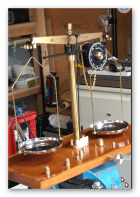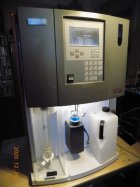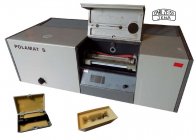I worked a lot in labs but I have never seen it. All of internal parts are made of metalYes analytical mechanical balances may require grounding to eliminate static charges which will effect accuracy.
You are using an out of date browser. It may not display this or other websites correctly.
You should upgrade or use an alternative browser.
You should upgrade or use an alternative browser.
Setting sensitivity and zero point of a mechanical lab balance
- Thread starter peter63
- Start date
"As I understand the operation - turning the adjuster (3) counter clockwise ie. raising it (raising the CofG) will make the balance more sensitive and less stable and will give more deflection for any given weight."
Absolutely agree principally -- I also guessed it. But "facts are stubborn things" -- deflection decreased..
And I don't understand, why..?
Maybe, I will try it again.. but a little bit afraid of making it worse...
Absolutely agree principally -- I also guessed it. But "facts are stubborn things" -- deflection decreased..
And I don't understand, why..?
Maybe, I will try it again.. but a little bit afraid of making it worse...
Is it possible you have a left hand thread on the adjuster (3), this would account for your finding, although I can see no reason why a LH thread would be used."As I understand the operation - turning the adjuster (3) counter clockwise ie. raising it (raising the CofG) will make the balance more sensitive and less stable and will give more deflection for any given weight."
Absolutely agree principally -- I also guessed it. But "facts are stubborn things" -- deflection decreased..
And I don't understand, why..?
Maybe, I will try it again.. but a little bit afraid of making it worse...
I have always assumed that the L & R zeroing adjusters have no effect on the sensitivity and C of G.
Hi 1066!
Now I made a second attempt.
As a starting point I double checked the central position of the libella, and
FIRST I rise the sensitivity rotating screw-3 CCW (as theoretically agreed), It massively shifted zero point (from 0 to approx +5 mg), but the span of deflection was between -5 mg and +5 mg with/without adding 10mg.
THEN zeroing by rotating screw-2 CW (so it moved a bit toward the center) until reaching zero position of the illuminated scale.
Thereafter I tested adding/removing +/- 10 mg -> deflection was 100% OK in both direction.
Thanks for your help and discussion!


Now I made a second attempt.
As a starting point I double checked the central position of the libella, and
FIRST I rise the sensitivity rotating screw-3 CCW (as theoretically agreed), It massively shifted zero point (from 0 to approx +5 mg), but the span of deflection was between -5 mg and +5 mg with/without adding 10mg.
THEN zeroing by rotating screw-2 CW (so it moved a bit toward the center) until reaching zero position of the illuminated scale.
Thereafter I tested adding/removing +/- 10 mg -> deflection was 100% OK in both direction.
Thanks for your help and discussion!
sparker
Silver $$ Contributor
Yup! Like he said.What a beautiful old mechanical balance - I've not seen one like that before but do have a couple of old Stanton balances of similar vintage.
As I understand the operation - turning the adjuster (3) counter clockwise ie. raising it (raising the CofG) will make the balance more sensitive and less stable and will give more deflection for any given weight.
One of my Stanton's (AD5)
View attachment 1688673
Great result.Hi 1066!
Now I made a second attempt.
As a starting point I double checked the central position of the libella, and
FIRST I rise the sensitivity rotating screw-3 CCW (as theoretically agreed), It massively shifted zero point (from 0 to approx +5 mg), but the span of deflection was between -5 mg and +5 mg with/without adding 10mg.
THEN zeroing by rotating screw-2 CW (so it moved a bit toward the center) until reaching zero position of the illuminated scale.
Thereafter I tested adding/removing +/- 10 mg -> deflection was 100% OK in both direction.
Thanks for your help and discussion!

Now you need to find another balance in poor condition that you can break up and use the parts to make a superior mechanical beam scale suitable for reloading.
ThanksGreat result.Unfortunately much too sensitive for reloading, unless you are trying to compare kernel size.
Now you need to find another balance in poor condition that you can break up and use the parts to make a superior mechanical beam scale suitable for reloading.
I think, at my first trial I experienced that turning screw-3 CCW shorten the deflection from 9 to 5 mg, but failed to check the deflection to the opposite direction (ie. when decreasing the load 10 mg again) as I did not imagine that sensitivity alignment would shift the zero position so crude.
Afterwards, the only possible explanation is that the threaded axis of sensitivity screw is not perfectly vertical.
But at the second trial, as you also justified my consideration, I firmly believed that this was the proper way
"Now you need to find another balance in poor condition that you can break up and use the parts to make a superior mechanical beam scale suitable for reloading." -- No thanks, I am really happy with this only one..
Attachments
@peter63, I have been collecting scientific instruments for 45 years and must say that balance of yours is impressive! I have a couple balance scales and yours would be a proud addition to any one's collection. I have one on display in my house that I still use on occasion. It is a Voland and Sons from New Rochelle, NY. I believe it is from the 40's or 50's. It was sitting unused in a lab I was working in in 1983 and I was told to get rid of it. So I did... I wish I could help, but none of my balances have a sensitivity adjustment. Danny


Dear 1066, Dear Danny!
Both balances are really marvellous!!
As I work as a service engineer of lab equipments, sometimes I use my balance for my job, eg. weighting some reagents for automatic titration devices.
So I don't collect balances, but some analytical equipments, instead
It was a great pleasure to discuss/conversate with you,
Best
Peter
Both balances are really marvellous!!
As I work as a service engineer of lab equipments, sometimes I use my balance for my job, eg. weighting some reagents for automatic titration devices.
So I don't collect balances, but some analytical equipments, instead
It was a great pleasure to discuss/conversate with you,
Best
Peter
Attachments
Similar threads
- Replies
- 19
- Views
- 1,093
- Replies
- 66
- Views
- 8,700
Upgrades & Donations
This Forum's expenses are primarily paid by member contributions. You can upgrade your Forum membership in seconds. Gold and Silver members get unlimited FREE classifieds for one year. Gold members can upload custom avatars.

Click Upgrade Membership Button ABOVE to get Gold or Silver Status.
You can also donate any amount, large or small, with the button below. Include your Forum Name in the PayPal Notes field.
To DONATE by CHECK, or make a recurring donation, CLICK HERE to learn how.

Click Upgrade Membership Button ABOVE to get Gold or Silver Status.
You can also donate any amount, large or small, with the button below. Include your Forum Name in the PayPal Notes field.
To DONATE by CHECK, or make a recurring donation, CLICK HERE to learn how.














